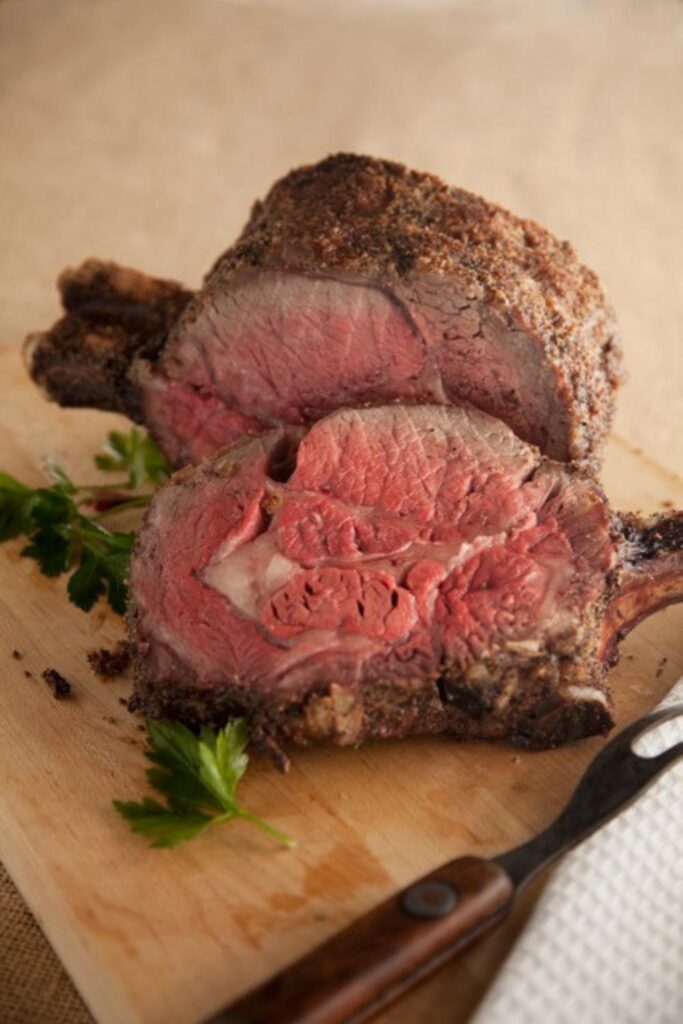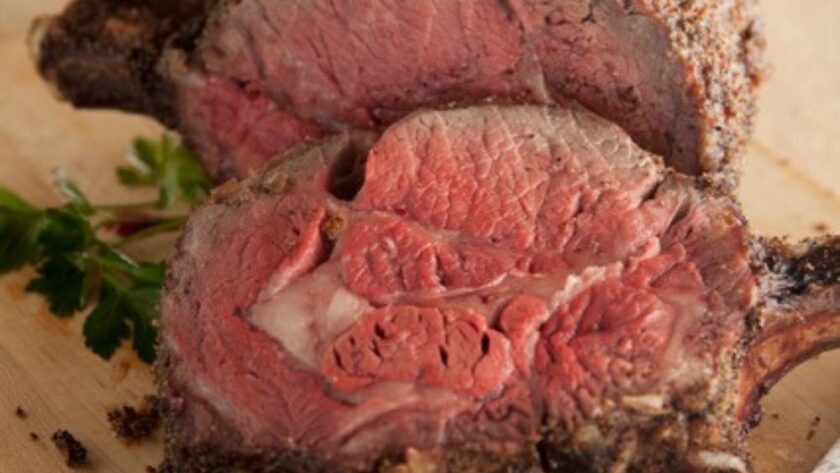This easy prime rib recipe by Paula Deen is perfect for a special dinner. With just two ingredients, you’ll get a juicy, tender roast that’s simple to prepare and impressively flavorful. The key to its foolproof success is the slow roasting technique, making it stress-free and ensuring perfectly cooked, melt-in-your-mouth results every time.
Ingredients Needed:
- 1 tablespoon Paula Deen’s House Seasoning
- 1 (5-lb) standing rib roast
How To Make Prime Rib Foolproof?
- Preheat the oven: Set the oven temperature to 375 °F (190 °C) to get it ready for roasting.
- Prepare the roast: Let the rib roast stand at room temperature for at least 1 hour before cooking to allow even cooking. Rub the roast thoroughly with Paula Deen’s House Seasoning to cover all sides evenly.
- Position the roast for roasting: Place the seasoned roast on a rack in a roasting pan with the rib side facing down and the fatty side facing up. This setup allows for even cooking and a juicy, flavorful result.
- Roast the prime rib: Cook the roast in the preheated oven for exactly 1 hour. After the hour is up, turn off the oven but do not open the oven door. This step is crucial to maintaining the residual heat for cooking the meat gently.
- Rest the roast in the oven: Keep the roast inside the closed oven for another 3 hours without disturbing it. This slow rest period lets the heat continue cooking the meat to a perfect medium-rare without drying it out.
- Reheat before serving: About 30 to 45 minutes before serving, turn the oven back on to 375 °F (190 °C) to warm up the roast for serving.

Recipe Tips:
- Choose the right cut of meat: A well-marbled standing rib roast will give you the juiciest and most flavorful results. Make sure it has a good layer of fat on top for self-basting while roasting.
- Bring the meat to room temperature: Letting the roast sit out for at least an hour before cooking helps it cook more evenly and reduces the risk of an undercooked center.
- Use a meat thermometer for accuracy: To ensure the perfect doneness, insert a meat thermometer into the thickest part of the roast. Aim for an internal temperature of 130-135 °F (54-57 °C) for medium-rare.
- Don’t skip the rest time in the oven: The three-hour rest period in the turned-off oven is essential for retaining the meat’s moisture and achieving that tender, melt-in-your-mouth texture.
- Reheat carefully before serving: When reheating, keep the oven door closed to maintain a steady temperature and avoid overcooking the outer layers of the roast. This will help preserve the juicy center.
How To Store & Reheat Leftovers?
- Refrigerate: First, let the leftover prime rib cool to room temperature. Once cooled, place the slices or whole piece in an airtight container or tightly wrap it with aluminum foil. Store it in the refrigerator for up to 3 days to maintain its tenderness and flavor.
- Freeze: Allow the prime rib to cool completely at room temperature. Wrap it securely in plastic wrap, then place it in a freezer-safe bag or container. Freeze for up to 3 months. To thaw, transfer the wrapped roast to the refrigerator overnight before reheating.
- Reheat: Preheat your oven to 300 °F (150 °C). Wrap the leftover prime rib in aluminum foil and place it on a baking tray. Reheat in the oven for about 20-30 minutes or until the internal temperature reaches 140 °F (60 °C) for a warm and tender result
Nutrition Facts
Serving Size: 1 serving (227g or 8 oz)
- Calories: 658
- Total Fat: 52.2g
- Saturated Fat: 20.4g
- Cholesterol: 182mg
- Sodium: 148mg
- Potassium: 499mg
- Total Carbohydrate: 0g
- Dietary Fiber: 0g
- Sugars: 0g
- Protein: 43.1g
Try More Paula Deen Recipes:
- Paula Deen Chicken Divan
- Paula Deen Beef Stew
- Paula Deen Baked Spaghetti
- Paula Deen Baked Mac And Cheese

Paula Deen Prime Rib Foolproof
Description
This easy prime rib recipe by Paula Deen is perfect for a special dinner. With just two ingredients, you’ll get a juicy, tender roast that’s simple to prepare and impressively flavorful. The key to its foolproof success is the slow roasting technique, making it stress-free and ensuring perfectly cooked, melt-in-your-mouth results every time.
Ingredients
Instructions
- Preheat the oven: Set the oven temperature to 375 °F (190 °C) to get it ready for roasting.
- Prepare the roast: Let the rib roast stand at room temperature for at least 1 hour before cooking to allow even cooking. Rub the roast thoroughly with Paula Deen’s House Seasoning to cover all sides evenly.
- Position the roast for roasting: Place the seasoned roast on a rack in a roasting pan with the rib side facing down and the fatty side facing up. This setup allows for even cooking and a juicy, flavorful result.
- Roast the prime rib: Cook the roast in the preheated oven for exactly 1 hour. After the hour is up, turn off the oven but do not open the oven door. This step is crucial to maintaining the residual heat for cooking the meat gently.
- Rest the roast in the oven: Keep the roast inside the closed oven for another 3 hours without disturbing it. This slow rest period lets the heat continue cooking the meat to a perfect medium-rare without drying it out.
- Reheat before serving: About 30 to 45 minutes before serving, turn the oven back on to 375 °F (190 °C) to warm up the roast for serving.
Notes
- Choose the right cut of meat: A well-marbled standing rib roast will give you the juiciest and most flavorful results. Make sure it has a good layer of fat on top for self-basting while roasting.
- Bring the meat to room temperature: Letting the roast sit out for at least an hour before cooking helps it cook more evenly and reduces the risk of an undercooked center.
- Use a meat thermometer for accuracy: To ensure the perfect doneness, insert a meat thermometer into the thickest part of the roast. Aim for an internal temperature of 130-135 °F (54-57 °C) for medium-rare.
- Don’t skip the rest time in the oven: The three-hour rest period in the turned-off oven is essential for retaining the meat’s moisture and achieving that tender, melt-in-your-mouth texture.
- Reheat carefully before serving: When reheating, keep the oven door closed to maintain a steady temperature and avoid overcooking the outer layers of the roast. This will help preserve the juicy center.

